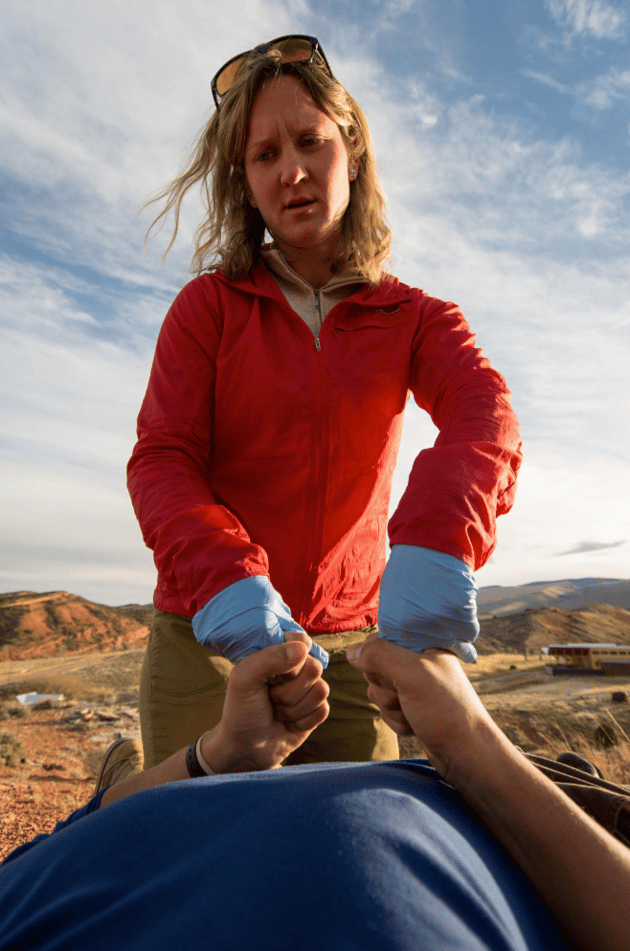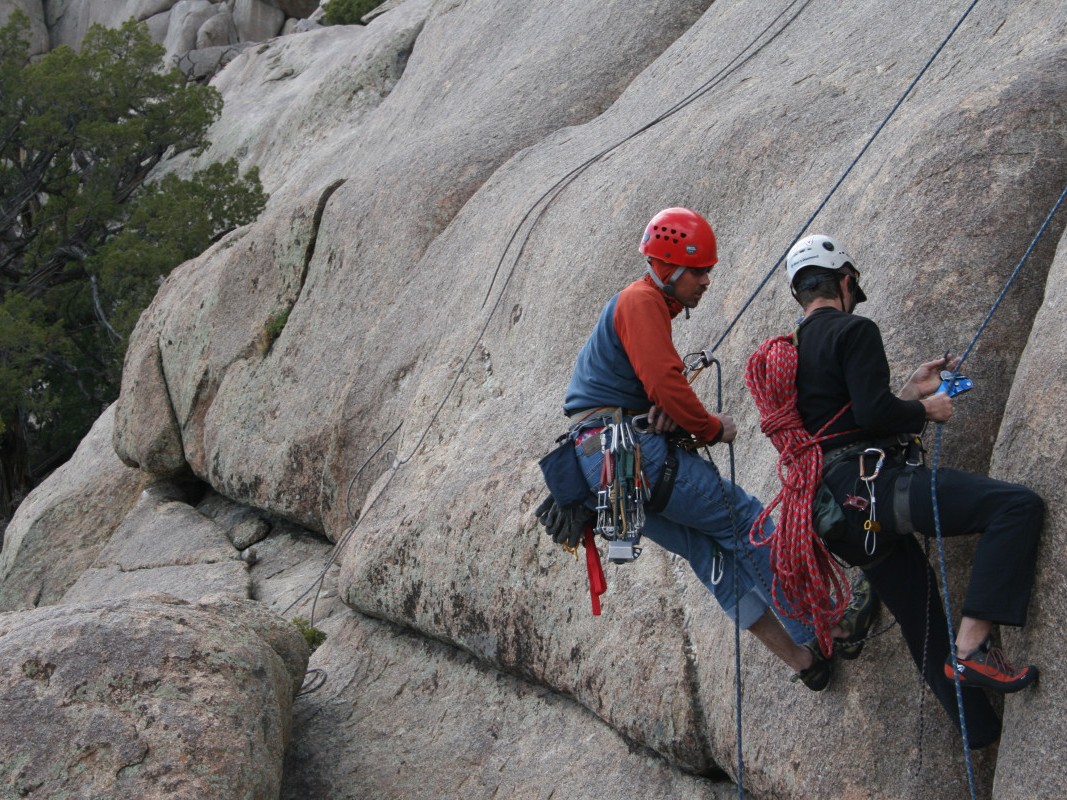
The Setting
You are hiking with a group of friends deep in a wilderness area. It’s lunch and everyone’s stomach is rumbling, but no one wants to stop long term.
Luckily, you have trail mix within arm’s reach. You feel comfortable passing it amongst your hungry group members because it doesn’t contain nuts.
However, soon after one of your friends becomes acutely ill. With a tingly and tight throat, your friend seems to be having an allergic reaction.
SOAP Report
Subjective
At about 1310 hours the 20-year-old patient began expressing concern over tightness and tingling in the throat and an inability to swallow that got worse over about 20 minutes.
There were no visible skin signs (no rash, no swelling). The patient administered one dose from their epinephrine auto-injector into their thigh. At present, 5 minutes later, they say their throat feels better and they can swallow.
Objective
Patient Exam: There is no mechanism for injury. At present the patient has no visible signs of rash, swelling or any other skin problem. They are not short of breath.
Vital Signs
|
Time |
13:30 |
|
Level of Responsiveness (LOR) |
A+Ox4 |
|
Heart Rate (HR) |
100, strong, regular |
|
Respiratory Rate (RR) |
22, easy, regular, no wheezes |
|
Skin Color, Temperature, Moisture (SCTM) |
pink, flushed, warm, sweaty |
|
Blood Pressure (BP) |
radial pulses present |
|
Pupils |
PERRL |
| Temperature | Not taken, patient states that they are warm and comfortable |
History
|
Symptoms: |
Initially patient complained of tightness and tingling in the throat and an inability to swallow. At present patient says there is slight tingling in the throat and they can swallow. They feel nauseous and nervous. |
|
|
Allergies: |
Patient has an allergy to nuts. |
|
|
Medications: |
|
|
|
Pertinent Hx: |
Patient has a history of an allergic reaction, which required epinephrine, one year ago. |
|
|
Last in/out: |
|
|
|
Events: |
|
STOP READING!
What is your assessment and plan? Take a few minutes to figure out your own assessment and make a plan. Don’t cheat—no reading on without answering this first!

Assessment
- Patient had an allergic reaction requiring an injection of epinephrine.
- Possible return of the allergic reaction (biphasic reaction).
- We have no other medications for this patient.
Plan
- Since we cannot treat a second reaction we are activating a PLB that one of the group members carries and will wait for rescue.
-
We have moved all group food away from the patient.
-
If no response from the PLB in one hour we will begin hiking to the trailhead.
The End of the Tale
Local SAR responded within 40 minutes to the PLB and was able to evacuate the patient, who did not experience a further reaction.
The rest of the group hiked out. The patient did not have nuts in their food but it is speculated that there was cross-contamination from other food in the group. Lessons learned are for more diligence in food hygiene to reduce the chance of exposure and to carry a second dose of epinephrine and antihistamines.
Comments
Our approach to treating anaphylaxis has evolved over recent years. It was once commonly taught that the purpose of epinephrine in the context of anaphylaxis is to buy time for antihistamines to suppress the allergic response. This is incorrect.
Epinephrine reverses the vasodilation, increases vasoconstriction and thus supports blood pressure. It decreases mucus production, bronchodilates and stabilizes the mast cells (decreases histamine release).
Epinephrine is much more powerful than antihistamines and is the gold standard medicine for anaphylaxis. Antihistamines are supportive medications that reduce the allergic response and may prevent ongoing or biphasic reactions.
Our current curriculum emphasizes administering epinephrine for anaphylaxis because there is the erroneous concept that antihistamines can correct anaphylaxis on their own. This is often not the case and delaying epinephrine can be dangerous.
Notes from NOLS: Injury/Illness Prevention is a Leadership Skill
There is also an approach to treatment of anaphylaxis that defines anaphylaxis as involving signs or symptoms in two body systems, e.g. a skin rash and tightness in the throat. While presence of allergic s/s in two body systems is a strong indicator of anaphylaxis, our curriculum approach is that:
- For any patient with a severe allergic reaction/anaphylaxis:
- any airway swelling (lips, tongue, uvula, voice changes);
- large areas of swelling;
- respiratory compromise or shock.
- Inject epinephrine (adult dose = 0.3ml/1:1000 intramuscular)
-
In addition, whenever the patient is able to swallow
- Oral antihistamines at recommended doses and continue during evacuation.
- If reaction reoccurs, continue to administer epinephrine.
- Evacuate.
This approach reflects current practices of early administration of epinephrine if there is any suspicion of anaphylaxis, especially in a patient with a history of a severe allergic reaction. Do not delay administration of epinephrine in anaphylaxis while waiting for an oral antihistamine to work
Antihistamines have a role in allergic responses. They can be helpful if there is suspicion of exposure with very early signs of a reaction and they can be helpful after epinephrine, but they do not substitute for epinephrine in anaphylaxis.
Written By
Tod Schimelpfenig
As a NOLS Instructor since 1973 and a WEMT, volunteer EMT on ambulance and search and rescue squads since the 70s, Tod Schimelpfenig has extensive experience with wilderness risk management. He has used this valuable experience to conduct safety reviews as well as serve as the NOLS Risk Management Director for eight years, the NOLS Rocky Mountain Director for six years, and three years on the board of directors of the Wilderness Medical Society, where he received the WMS Warren Bowman Award for lifetime contribution to the field of wilderness medicine. Tod is the founder of the Wilderness Risk Manager’s Committee, has spoken at numerous conferences on pre-hospital and wilderness medicine, including the Australian National Conference on Risk Management in Outdoor Recreation, and has taught wilderness medicine around the world. He has written numerous articles on educational program, risk management and wilderness medicine topics, and currently reviews articles for the Journal of Wilderness and Environmental Medicine. Additionally, he is the author of NOLS Wilderness Medicine and co-author of Risk Management for Outdoor Leaders, as well as multiple articles regarding wilderness medicine. Tod is the retired curriculum director for NOLS Wilderness Medicine and is an active wilderness medicine instructor




.jpg)